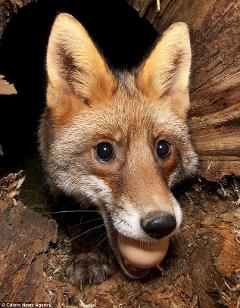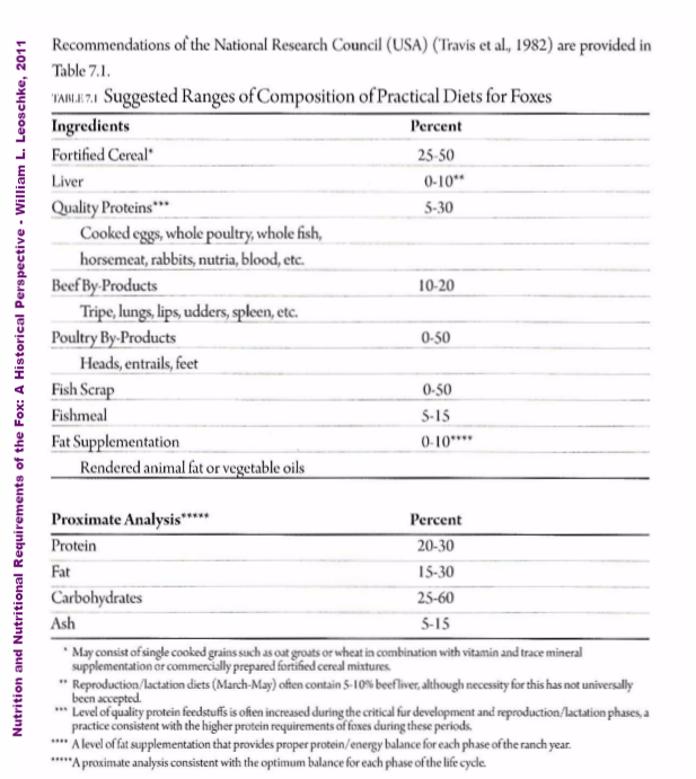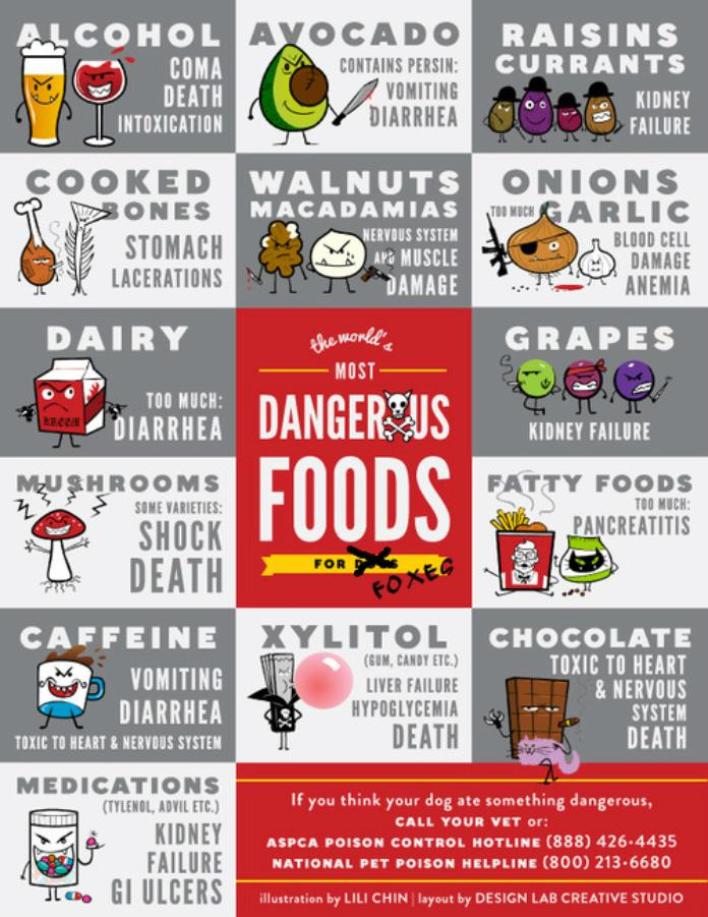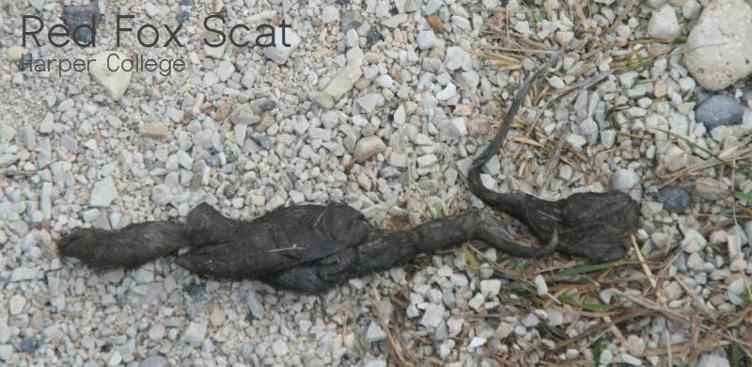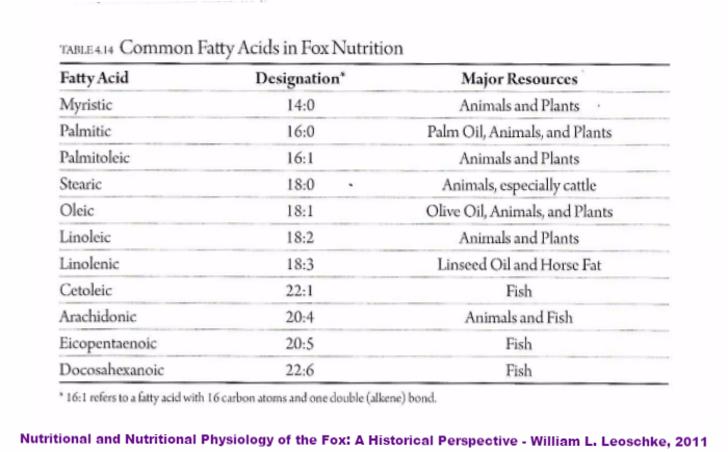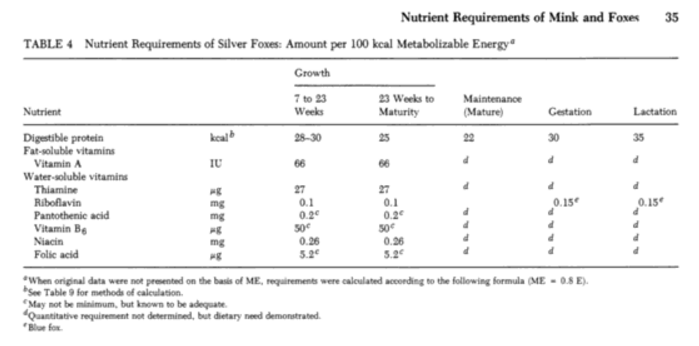
Silver Fox Diet And Nutrition
A wild fox is estimated to eat around 400g of food a night, which is roughly equivalent to a young rabbit or around 5-10 rodents, depending on size. A fox has a relatively small stomach for it's size and consumes around 10% of it's bodyweight, compared to around 20% for dogs and other canines. Over a course of a year, wild foxes are thought to consume around 150 kg of food.
Foxes are primarily carnivores, but they are often best described as omnivorous or opportunistic carnivores, eating a wide variety of foods, including;
- Rodents, Squirrels & Rabbits
- Birds, Wildfowl & Eggs
- Amphibians & Small lizards
- Insects, Earthworms & Grubs
- Fruits, Nuts & Berries,
- Grasses, Herbs & Vegetables
- Grains, Acorns, Fungi, Shoots & Seeds
- Commercial Cat & Dog Food
- Human Food Waste
While foxes do eat a variety of foods, it is important to remember that their digestion and physiology remains primarily geared towards the digestion of small ground dwelling prey species;
"The best available research indicates 95% of an average rural fox’s diet consists of meat, both hunted and scavenged, and mainly rabbits, rats, birds and small mammals. Insects and worms may constitute another 4% and the remaining 1% may consist of fruit.
However, in an urban area, natural prey and scavenged meat may cover only 55% of diet. Insects and worms add a hefty 20%, fruit – 7%, with household leftovers making up the remaining 18%."
Feeding a captive fox;
Foxes like to eat little and often and self-regulate their diets by caching any excess food. If you find your fox is caching a lot of food or not retrieving cached items within 24-48 hours, then you will need to adjust your diet and routine in order to reduce waste and to increase interest in food and enrichment.
In the nature of routine and for training purposes, it is best to feed your fox twice a day (breakfast and tea). Keep these meals small, plain, balanced and consistent (complete dry diet with raw meat and cooked veggies is the diet base - use complete puppy or kitten food for young foxes). A balanced and nutritious diet will be high in prey items, it is best this part of your foxes diet is fed in the form of food enrichment to keep them entertained throughout the day. Basic's include;
- Prey items; Chicks, whole poultry and game birds, mice, rats and rabbits, etc.
- Invertebrates; Crickets, locusts, waxworms, mealworms and earthworms, etc.
- Eggs; Quail, duck, goose and chicken, etc.
- Raw meat (on or off the bone; no pork due to roundworm risks)
- Raw organ meat; including liver, kidneys and heart on occasion (a diet of at least 10% of organ meat is recommended for dogs)
- Cooked meats (without bones, pork is OK if cooked thoroughly)
- Commercial diets - High quality, complete diets for cats and dogs (both wet and dry) can be used, there is also specialist Badger & Fox Food for those in the UK. Zupreem and Mazouri produce complete diets for exotic cats and canines for those in the US.
- Fresh fruits and berries (remove seeds and cores from fruits; no currents, citrus or rhubarb)
- Cooked and raw vegetables (no mushrooms, onions, garlic or raw/unripe potatoes)
Occasional treats can include;
- Honey
- Natural yogurt
- Nuts and seeds (no macadamia nuts, chestnuts or fruit seeds)
- Dehydrated and dried fruits, berries and veggies (remember nutrient value is concentrated into a lower weight - feed the dried weight equivalent of the fresh fruit item)
- Cottage Cheese
- Coconut oil
- Maple syrup
- Marmite (high in salt, so small amounts only)
- Bovril (high in salt, so small amounts only)
- Unsalted and unsweetened popcorn
- Unsalted and unsweetened porridge
- Tuna or salmon (fish can cause disease in foxes if it makes up more than 10% of diet)
- Cooked kidney beans, pinto bean and black beans (be aware, not all beans are safe)
- Cooked chickpeas and lentils
Carnivore care is also available in the UK as a supplement, for foxes that need extra nutritional support.
Example of a daily fox diet for an adult fox, from a UK fox breeder:
- x2 day old chicks or a raw chicken thigh
- x1 400g tin of wet dog food
- x1 portion of dry cat or dog biscuit (follow feeding guidelines on packaging for weight)
- 1/2 an apple, 1/2 a carrot and a few blueberries (as scatter feed)
- Dog chocolate buttons and mealworms given as an occasional treat
Farm Fox Suggested Diet Composition;
Calories Foxes Require to Ensure Maintenance;
This is termed Metabolic Energy Requirement for Maintenance (MEm), it is the estimated amount of energy used in an adult fox whilst in a thermoneutral environment. It represents the amount of energy spent in obtaining and digesting food in order to maintain a normal body weight.
The table below details the results of studies into the energy requirements of silver foxes and details a fox's daily calorie requirements (Cal/kg/day);
What Foxes Can't Eat;
Foxes are canids, but not canines. Their dietary needs are specific for their vulpine genus, which shares many convergent traits with the feline persuasion - they are the 'catlike canid'. While there are no specific studies into food toxicity in foxes, like dogs and cats, foxes can be intolerant to many different foods. As a general rule of thumb it is advised you do not feed your fox anything that cannot be given to dogs and cats. While some of the foods listed below have been given to foxes without any ill effect, until the mechanisms are known by which suffering is caused, it is advised not to tempt fate.
It is also important to note that uncooked oily fish must not make up more than 10% of a foxes diet, as this leads to a potentially fatal B1 Vitamin deficiency, named Chastek Paralysis;
"Chastek paralysis, an acute dietary disease of foxes, is caused by including 10% or more of certain species of uncooked fish in the diet and may be prevented or cured by giving adequate amounts of thiamine"
Physiological Availability of the Vitamins - Daniel Melnick, 1945
Do Not Feed Foxes;
- Rawhide - They lack the facial muscles dogs do and cannot chew bones or gnaw rawhide.
- Processed Foods - This food is high in salt and can create long term health issues in foxes.
- Uncooked Pork - This can carry a risk of Trichinella for foxes in the UK.
- Cooked Bones - Cooked bones are brittle and splinter, causing a whole host of deadly issues.
- >10% of Oily Fish - This can cause vitamin B1 deficiency in foxes when fed in amounts over 10%.
"According to the American College of Veterinary Pharmacists, salt toxicosis can occur when a dog eats as little as two to three grams of sodium chloride for every kilogram of body weight"
American Kennel Club
'Foods Unsafe for Dogs' by Lili Chin, also applies to foxes;
"No matter how good it feels to dish out treats, you should exercise restraint.
Human food can be extremely dangerous for your [pet]. [Foxes] evolved on a diet featuring small mammals, birds and rodents. As a result, your [pet's] liver is very specific about the toxins it can tolerate.
Some ingredients humans can filter safely are toxic to your pets. Do you know which ones? Then you should read this useful list of foods all [pet] owners should avoid."
30 Foods And 470 Plants To Never Feed Your Cat - Catological
Legacy of the Silver Fox
How Foxes Assisted in the Formulation of Complete Diets and the Development of Scientific Research:
The Fromm Brother's began their fur farm with 12 pairs of silver foxes in 1921, by 1925 they had began developing their own foods and treats. In 1933, as a result of their attention to the dietary needs of their foxes and the development of the first formulated diets for canids, the Fromm Brother's were the first farm to produce a litter of eleven silver fox pups (in contrast wild foxes have 4-5 pups and the odd's of getting just one silver are very slim). They credit their success to their formulated diets and superior nutrition, as a result of their success a boom in the production of commercial fox diets began.
"Fromm Bros. Nieman Company's innovative breeding techniques and sound nutrition result in the world's very first litter of eleven silver foxes which were born on the company's farm in Mequon-Thiensville.
Today the Fromm Brother's no longer farm fur animals, but they still produce pet food to this day.
In 1921 Purina revolutionised the domestic animal feed industry by turning the idea of formulated and complete diets into pellet-shaped feed. "Purina Fox Chow" was one product produced commercially for fox farmers that by 1932, had found a place as a staple diet for laboratory rodents. The commercial fox diets were provided to laboratory rodents in replacement of the unsuitable milk and lettuce diets they were originally being fed, as a result, it greatly improved the health and mortality of the animals and the reliability of research.
"Mice were fed Purina Fox Chow supplemented with bread and milk and either lettuce or cabbage"
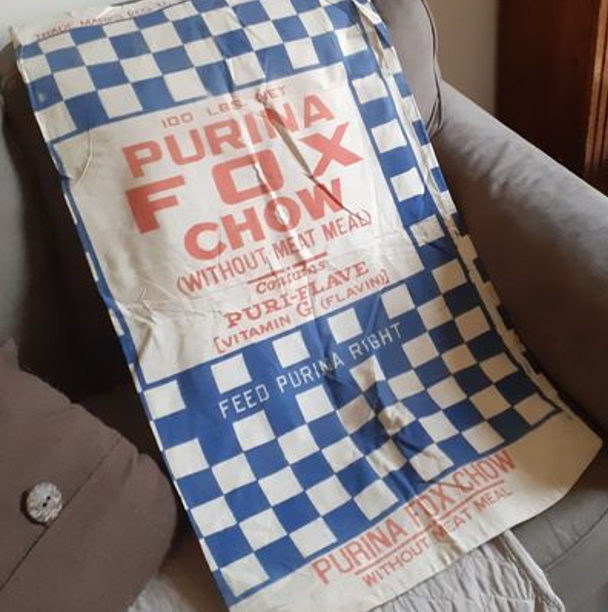
Fox Feeding Behaviour
Foxes will 'cache' or bury surplus food for later consumption when food is scarce; the foxy version of a fridge. It is important to allow your fox to exhibit this natural behaviour, which is an adaptive survival strategy that allows the fox to maintain a constant food supply throughout the year, despite seasonal variation and competition.
Caching is usually no more than simply placing the food in a carefully selected hole, which is then lightly covered with soil until it is needed. Some foxes will also use stumps or similar such structures and many pet foxes will cache food items in sofas or under bedding.
Caching sites may be scent marked before or after the cache has been emptied with either urine or faeces, depending on the contents. This behaviour is most often seen after a cache has been emptied but it can be seen prior, essentially it is a chemical note that tells the fox it has been there before (so not to waste time following the same false trails). Burying unwanted food helps the fox keep its environment clean, so if they bury it and defecate or urinate on the cache directly after, it is likely 'waste', not a 'snack for later'.
Foxes will also scent mark water sources, so it is advised fox owners invest in a raised, non-tip bowl and change the water daily (ponds and water troughs work well in enclosures and can be utilised along with food enrichment). Up to 66% of a foxes water requirement comes from food, with up to 14% coming from specific water sources. Farmed foxes have a water consumption rate of 100-600 ml/day.
Foxes are known to engage in two types of caching behaviour;
- Larder caching; 'Saving for a rainy day' - few large cache sites, with multiple items and close locations, often actively defended. More often associated with abundant resources for use when food is scarce.
- Scatter caching; 'Don't keep all your eggs in one basket' - placing food items for storage in individual and multiple scattered sites. This behaviour helps to protect resources from being lost to others and guarantees when a fox returns to its caching sites, at least some of the food will still be there.
What is the likelihood of a fox ever returning to its cache?
"Well, much of the data available suggest that foxes have a good spatial memory, aided by the use of urine and faeces to mark cache sites. In their 1996 paper Sklepkovych and Montevecchi found that of 67 petrels caught by two foxes, 22 (33%) were eaten, while all but two of the remaining birds were partially eaten before being cached in one of 45 scatter hoards. Of those cached, 12 (28%) were recovered within 24 hours, 17 (41%) within two days, 22 (53%) within one week, 26 (62%) within two weeks and 1 within three weeks.
This suggests that at least 62% of the caches were recovered during the study period and, whether or not foxes subsequently recovered the remaining caches is unknown.
Oxford University’s David Macdonald and three colleagues reported higher recovery rates in a 1994 paper to the Journal of Mammalogy. During their study in Dalyan, on the coast of Southwest Turkey, Prof Macdonald and his co-workers found that Red foxes retrieved 94% of scatter cached Loggerhead turtle (Caretta caretta) eggs (no larder hoarding was observed), 80% on the subsequent night."
Pet fox caching food rewards during a training session;
Playing with Food;
It is through play that young foxes develop the coordination and timing necessary to become a successful hunters. They learn to adjust their speed to a moving target, and to gauge distance when pouncing. Playing with food gives young foxes the opportunity to learn the necessary skills for hunting through practical experience.
In the wild, mother's will teach their young to hunt through bringing home dead prey and consuming it in front of them, until they learn to join in. Over time she will begin to supply partially dead prey, showing them how to finish a kill. The young foxes continue to learn to hunt on wounded, slow moving targets until they are skilled enough to go off and practice hunting alone.
As with young wild foxes, young pet foxes will play with food or toys as a means to develop these natural hunting skills further. By providing food enrichment for you fox, you will be supplying them with the opportunity to develop their natural behaviours, despite the absence of live prey to practice on.
Food Fights;
Foxes are solitary hunters, which means they are not as willing to share food or resources as "pack animals" are. This means foxes can be very possessive over food and will often vocalise and display agonistic behaviours if they are approached when eating or if their cached supplies are approached. This behaviour is considered normal for foxes but it is similar to food aggression seen in dogs and can be remedied and managed with desensitisation and counter-conditioning techniques and by wearing animal handling gloves during the first weeks of training.
Foxes can become anxious and confrontational when they are hungry and can smell a tasty treat, instinct takes over and they are willing to resort to begging, whining and shoving in order to get to the source of the smell. If those methods do not work, they may resort to more aggressive methods, so consistent training is necessary around food. Never give in to their begging, as this will only serve to reward them for the behaviour and increase it's occurrence.
Foxes are not considered "sly" without reason and have almost turned the art of food theft into a science! Once a fox has stolen a food item they are extremely reluctant to give it back, and may bite to defend their prize. This behaviour can be dangerous and must be discouraged, as your fox may one day get hold of an item that is not safe for their consumption. In order to remedy such situations make sure food items are kept out of reach, counters are kept clean and bins are not accessible.
Keep your fox well fed with a varied nutritious diet, provide lots of food enrichment (on a rota and rotation schedule to keep it the act of eating stimulating) and keep your foxes main meal times regular. Keep your fox away from the kitchen during meal times by creating a distraction (or by teaching them to do something else with their time), and don't forget to reward them for not pestering you when you are cooking or eating!
Teach your fox the "leave it" command and use both distraction and counter-conditioning techniques, as you would with dogs, to retrieve stolen items.
Also remember to allow your fox to cache the food you provide (if they so wish), by providing a safe spot for them to do so (this is why a dig box or sand pit is necessary for foxes). Do not remove cached food from this "safe" place, but do get your fox used to you being near it with desensitisation and counter-conditioning techniques, (unless it has been there for more than 48 hours - in which case, remove it when they are out of sight). This will ensure your fox learns to understand they have little need to guard resources.
Applying these techniques will ensure the behaviours foxes naturally display around food can be effectively managed and reduced/eliminated, for the safety of all involved.
The Feeding Behaviour of Farmed Silver Foxes;
Studies into the behaviour of farmed silver foxes with regards to food found that the way in which food is presented can influence how the foxes respond. They found that an availability of excess food leads to eating habits becoming variable and a reduced interest in food enrichment.
"Food is frequently used as a ‘yardstick’ in operant experiments. However, previous work on silver foxes had suggested that how food is presented can affect how they respond to it, with excess food leading to variable consumption rates, and cages containing food being avoided over control cages except while eating.
Our first experiment therefore examined foxes’ consumption of excess food in more detail by comparing their daily intakes with foxes fed a control diet for 4 weeks. Eighteen silver fox vixens were assigned to one of two groups in which the experimental group (N = 9) was feed 2.5 times that of control (N = 9). Although appetite, measured as the amount of food consumed, tended to fluctuate none of the overly fed foxes stopped eating during the experimental period. On average, the excessive fed group consumed more food (18 g/day) compared to the controls ( 12 g/day).
In Experiment 2 we aimed to test whether the presence of excess food affected the foxes’ use of the cage. Five silver fox males were housed in separate multi-compartment apparatuses and the position of a food bowl was randomly switched between two cages for 18 days. The subjects had to perform one operant response to enter each cage and time inside the compartments was calculated. The foxes spent significantly less time in the food compartment (4 h 13 min), compared to the empty cage (12 h 12 min) and as expected by random (8 h) (P < 0.05).
These results confirm that ad libitum fed silver foxes have a more fluctuating intake rate than animals fed just below maintenance, and that placing food in a cage reduces the time spent there. The day-to-day use of food, and perhaps even its value, can therefore be shaped by how it is presented. Implications for using food as a yardstick resource for silver foxes is that the ration should be held at maintenance. Also, to control for a motivation to leave food positioned in the operant test cage a free control cage distant from food could be provided."
Silver Fox Nutritional Statistics
"It is important that people raising foxes understand the foxes’ nutritional requirements in order to establish a sound feeding program. There are two types of feed used in the fox industry: pelleted dry feed and wet feed. Pelleted feed is most often offered free choice. Wet feed is fed at least once daily. Nutritionists and veterinarians are valuable resources for producers to consult regarding nutritional needs, changes or concerns.
Proper nutrition and body condition management helps to prevent or manage metabolic diseases, over-conditioning and other health and welfare issues.
Foxes have a higher demand for protein and fat than most other domestic livestock. Fox nutrient requirements vary considerably throughout the year. Foxes typically have a reduced appetite during winter (December – February)... therefore, the diet’s composition may need to be adjusted. Foxes that are more active require more nutrients for maintenance. Nutrient deficiencies can lead to health problems for foxes."
Code of Practice for the Handling of Farmed Fox (Vulpes vulpes)
Nutritional Physiology;
Foxes have a digestive tract around 200 cm in length and have a similar intestine/body length ratio as cats. However, the average food passage time for a fox is around 6-10 hours. much shorter than the 20 hours cats average. It is estimated that silver foxes will defecate a total amount of 22 kg/year. A fox fed a healthy nutritious diet will have healthy stools, which are around 3-6 inches in length, dark, firm, partly segmented in shape and have a slight twist to one end.
Nutritional Breakdown;
Foxes, like other animals require different components in their diet to maintain optimum health and digestion. The main components necessary for formulating a fox diet include;
- Carbohydrates - Carbohydrates are an important source of energy. They provide an essential supply of glucose which is required for cellular metabolism. There are two types of carbohydrates; complex carbohydrates (which can be found in grains, cereals and starchy vegetables), and simple carbohydrates (which can be found in fruits, vegetables and milk). Studies show foxes cope with the digestion of both simple and complex carbohydrates.
- Fat & Essential Fatty Acids - Fat is vital for the body to be able to utilise the fat-soluble vitamins A, D, E and K. Fat also provides the body with Essential Fatty Acids. These components cannot be made my the body, so must be obtained in adequate supply from food. There are two types of fatty acids; saturated fatty acids, which are complex and difficult to break down (found in animal meat, certain oils, dairy products and processed meats), and unsaturated fatty acids which are much easier to digest (found in nuts, plant oils and fish).
- Protein & Amino Acids - Proteins are made up from chains of 21 different amino acids. These amino acids are the main components of muscles, organs and endocrine glands. They assist with the maintained of skin, teeth, bones, hair and blood components, as well as aiding homoeostasis of water balance within the body. Amino acids can be essential (of which there are 11), semi-essential (of which there are 2) and non-essential (of which there are 8). Protein is obtain from animal meat, nuts and seeds, eggs, dairy products, legumes and soya.
- Vitamins & Minerals - This is usually added to formulated animal foods in the form of ash. Ash contains the trace minerals left over after the carbohydrates, protein and fats have been burnt away. The main components of ash are usually phosphorous and calcium, but it also contains other minerals such as iron and zinc.These vitamins and mineral are necessary for maintaining biological functions, deficiencies or excess of which can cause ill health and even death as a result.
Amino Acid Requirement of the Fox;
Essential:
Semi-Essential:
Non-Essential:
Arginine, Histidine, Isoleucine, Lysine, Methionine, Phenylalanine, Taurine, Threonine, Tryptophan and Valine
Cystine and Tyrosine
Alanine, Aspartate, Glutamate, Glycine, Hydroxy-Proline, Norleucine, Proline and Serine
There have been very few studies into the amino acid requirement of silver foxes. From what little research exists there are 3 amino acids that have noted significance;
- Methionine - In terms of fur development, methionine is, without question the most valuable limiting resource, as it is the major metabolic source for cystine, the key component of fur. For this reason it is given in ratio with cystine to promote fur growth.
- Taurine - Several studies have shown that like the cat, foxes have a specific dietary requirement for taurine as, unlike other animals, they are unable to synthesize enough taurine themselves to maintain optimum levels. Taurine is found in raw animal meat, but it is destroyed by cooking. A diet high in rodents, insects and raw meat will provide the extra requirement their bodies cannot produce themselves.
- Tryptophan - Studies have shown that tryptophan has a positive influence on the behaviour response of animals. Dietry supplementation with tryptophan has been found to aid in reducing fear and enhancing exploratory behaviour in the female silver fox. High levels of tryptophan have the potential for psycho-pharmacological properties. in that tryptophan is a precursor to serotonin. It has also been noted that tame foxes produce 34% more tryptophan than their aggressive counterparts.
Common Fatty Acids in Fox Nutrition;
Fat Soluble Vitamins Required by Foxes;
Fat-soluble vitamins are found mainly in fatty foods and animal products, such as vegetable oils, milk and dairy foods, eggs, liver, oily fish and butter. While foxes needs these vitamins to function, they don't need to eat them daily. This is because their bodies store the vitamins in their liver and fatty tissues for use later down the line, ensuring they are available when they are needed. Water soluble vitamins include;
- Vitamin A - Required for maintaining the integrity of epithelial tissues and optimum connective and nervous tissue structures. Vitamin A is important for vision, bone growth, gene expression, reproduction and physiological functions such as digestion and hormone regulation. Found in foods such as sweet potatoes, carrots, dark leafy greens, apricots, melon, mango and tuna.
"In terms of the fox, the animals can utilize beta-carotene as a source of vitamin A, but such utilization is poor and not as effective as vitamin A per se... Thus the recommended of the National Research Council... for the optimum vitamin A nutrition of growing foxes is a minimum of 100 IU of vitamin A or 600 IU (360 micrograms) of beta-carotene/kg body wt/day."
Nutritional and Nutritional Physiology of the Fox: Fat Soluble Vitamins, 2011
- Vitamin D - Vitamin D has several important roles, most importantly, helping to regulate the amount of calcium and phosphate in the body, which aid in keeping your foxes teeth and bones healthy. A lack of vitamin D can cause conditions such as Rickets and bone pain, While we call it a vitamin, vitamin D is actually a hormone. Most of a foxes requirement of vitamin D comes from sunlight, but vitamin D is also found in small amounts in oily fish, eggs and fortified cereals.
"An animals requirement of vitamin D is determined by multiple factors including the calcium/phosphorous ratio. Experimental studies... indicated that with an optimum Ca/P ratio of 1/1 rickets was not produced... However, vitamin D was required for optimum bone growth. A diet providing 0.1% calcium and 0.52% phosphorous, 95 IU of vitamin D/fox/day did provide slight bone healing in one rachitic pup... Studies...indicated that a control diet of natural feedstuffs that assayed 0.82 IU of vitamin D/gram or 22 IU per 100 kcal ME was adequate for growing foxes."
Nutritional and Nutritional Physiology of the Fox: Fat Soluble Vitamins, 2011
- Vitamin E - Vitamin E is a powerful, natural anti-oxidant that is utilized as part of a cellular defence system that protects the cell membranes. It is known to have a significant role in maintaining pregnancy, maintaining healthy skin and eyes, and in strengthening the immune system. Vitamin E can be found in a variety of food sources including; Plant oils, nuts, seeds and wheat-germ (which is found in cereal and cereal products).
"There are no specific studies reported in the scientific literature on the vitamin E requirements of foxes, these recommendations are based on experimental work with mink... 25 mg/kg of dry matter or 6.6 mg/1,000 kilocalories of ME was ample for mink. Harris and Embee... recommended an extra level of vitamin E directly related to the level of PUFA present, that is 0.6 mg/gram of PUFA diet."
Nutritional and Nutritional Physiology of the Fox: Fat Soluble Vitamins, 2011
- Vitamin K - Vitamin K serves several important functions. Most notably is it's need for blood clotting and wound healing, there is also evidence vitamin K may be necessary to help keep bones healthy. Vitamin K is found in; green leafy vegetables, vegetables oil and cereal grains. Small amounts are found in meat and dairy products.
"The synthesis of vitamin K by the intestinal flora of animals is a significant and adequate resource for most animals. However, circumstances may arise wherein vitamin K supplementation of the diet is warranted. Perel'dik et al... reported that on farms where silver foxes and blue foxes were born with subcutaneous and internal organ haemorrhaging, the enrichment of the diet of pregnant foxes with witamin K was beneficial."
Nutritional and Nutritional Physiology of the Fox: Fat Soluble Vitamins, 2011
Water Soluble Vitamins Required by Foxes;
A fox's body does not store water-soluble vitamins, so they need to consume them on a regular basis to ensure they have what they need. If an excess is consumed, the extra vitamins are excreted when the fox urinates. Unlike fat-soluble vitamins they can be destroyed by heat or by being exposed to the air and can be diluted in water. This means that by cooking foods, especially boiling them, some of the nutritional content is lost. The best way to stop your fox from not getting enough of the right nutrition is feed raw foods. Water soluble vitamins required by foxes include;
- Vitamin C - There is no specific data regarding the vitamin C requirements for foxes but they are known to have the physiological capacity to synthesize ascorbic acid, unlike humans. Experimental studies have shown that a vitamin A deficiency leads to the reduced synthesis of vitamin C, with vitamin C supplementation acting as an antioxidant. Found in kale, broccoli, cauliflower, spinach, papaya, kiwi, blackberry and strawberries.
- Vitamin B1 (Thiamine) - Several studies have been conducted in the thiamine requirements of foxes. Recommendations range from 0.8 mg to 5 mg/kg of dry matter. The National Research Council (USA) recommendation is 1.0 mg/kg of dry matter per fox. Fish, insects, seeds, nuts and green peas are all high in sources of vitamin B1.
- Vitamin B2 (Riboflavin) - Experimental work with silver foxes indicated that riboflavin requirement for foxes is greater than 1.25 mg/kg and less than 4.0 mg/kg of diet. The National Research Council (USA) recommend 2.0 mg/kg of diet. Found in dark, leafy greens, animal meats, fruit, nuts, seeds and whole-grains.
- Niacin - Recommended minimum requirement is 0.4 mg/kg body weight. The National Research Council (USA) recommend 10 mg/kg of dry diet. Farm fox diets contain around 50-70 mg/kg dry matter. Brewer's yeast, baking yeast and liver provide excellent sources of niacin. It can also be found in fortified grains and cereals.
- Vitamin B6 - A level of 2.0 mg/kg will prevent signs of deficiency in foxes. Brewer's yeast and baking yeast provide good sources of vitamin B6 as are seeds, nuts, animal meats, bananas and spinach.
- Pantothenic Acid - Research has shown that the foxes requirement for panthothenic acid is greater than 2.5 mg/kg of dry matter and less than 15 mg/kg of dry matter. The National Research Council (USA) recommend 8.0 mg/kg of dry matter. Food high in pantothenic acid include; yeasts, liver, skimmed milk and fortified cereals and whole-grains.
- Choline - Although most animals are able to synthesize choline by utilizing methionine, foxes are not able to meet their requirement alone, however, the choline requirement for foxes has yet to be established, but studies have indicated that a level of 1 mg/kg proved sufficient for foxes. Vitamin B12 is involved in the synthesis of methionine, meaning the level of vitamin B12 in fox diets could have a significant effect on choline requirements. Found in eggs, dairy, liver, nuts and vegetables.
- Biotin - There is yet no data available for the nutritional requirement of biotin in a foxes diet as this vitamin is synthesized by the intestinal gut flora of the fox, which allows it to meets it's own needs. Biotin is found in carrots, nuts, dairy, eggs, berries, fruits and vegetables such as cauliflower and cabbage.
- Folic Acid - Although foxes are able to synthesize folic acid in their intestinal flora, it is not sufficient to meet their daily needs. It is suggested a foxes diet should contain 0.2 mg/kg of dry diet. Source of folic acid include; dark leafy greens, broccoli, cauliflower, legumes, seeds and nuts, corn and carrots.
- Vitamin B12 - There is not yet data available on the nutritional requirement of vitamin B12 in foxes. Food sources of vitamin B12 include; Brewers yeast, liver, animal meat, eggs and dairy.
Minerals and Mineral Ratio's;
Minerals have a wide range of functions in the anatomy and physiology of the fox and are essential for maintaining health. These essential minerals can be divided into two groups, depending on how much of them is needed on a daily basis;
- Macro-minerals or just "minerals" such as calcium, chloride, magnesium, phosphorous are required in relatively large quantities.
- Micro-minerals or "trace elements" such as copper, iron, iodine, manganese, molybdenum, selenium and zinc,which are required in relatively small quantities.
What is a mineral Ratio?
Mineral ratio's represent homeostatic balance within the body and are just as important as the individual mineral levels themselves, especially when determining deficiencies.
Basic mineral ratio's of note in foxes include;
- Calcium/Phosphate - High or low ratio's may reduce calcium and phosphate absorption and bring on secondary mineral deficiencies as a result.
- Calcium/Phosphate/Magnesium - Excessive calcium or phosphate in the diet may decrease the absorption of magnesium and vice versa.
- Copper/Zinc - Copper and zinc are known to "compete" for absorption. An excess of either mineral will reduce the absorption of the other.
- Molybdenum/Copper - Excessive molybdenum in the diet results in copper deficiency, with low levels being associated with copper toxicity.
Minerals in Farm Fox Diets;
- Calcium/Phosphate - As calcium and phospherous are so closely linked they are often considered together. They are vital for the body, ensuring heart, muscles and nerves to function properly and can be found in a wide variety of food sources. The recommended calcium requirement for a fox aged from 7-37 weeks is between 0.5-0.6% of dry matter. The recommended calcium and phospherous intake for a fox is 0.6-1.0% Calcium to 0.6% - 0.8% phospherous, with a Ca/P ratio of 1/1 - 1.7/1.
- Chloride - Chloride is vital for maintaining correct osmotic pressure within the body and is a component of gastric secretions. Chloride requirements are closely related with sodium requirements and a new area of research has opened up to investigate this association further in the silver fox. However, as yet, there is no data available on the chloride requirement of foxes. Chloride is found in table salt (Sodium chloride).
- Chromium - Chromium has been identified as an essential trace element, regulating carbohydrate metabolism and assisting in insulin function. Animals deficient in chromium have a reduced ability to metabolise glucose. There is currently no scientific literature on the chromium requirement of foxes. Chromium is found in Brewer's yeast, green beans, broccoli, nuts and egg yolk.
- Cobalt - There is no data available on the cobalt requirement of foxes. However, foxes require vitamin B12, which contains 4.3% cobalt. Cobalt is a trace element and food sources include fish, nuts, cereals and green leafy vegetables.
- Copper - Copper is a trace element that aids in cellular respiration and connective tissue formation. Copper is also involved in the synthesis of melanin and aids in production of heamoglobin. Copper deficiency may also result in secondary iron deficiency as a result. There is no scientific data on the copper requirements of foxes, but foods such as liver, fish, goat's cheese and sesame seeds are all good sources of copper.
- Iodine - Iodine is a trace element and a component of the thyroid hormones, it is involved in the regulation of cellular metabolism. There is no scientific data on the iodine requirements of foxes, however, mink fed 4.1 ppm iodide maintain optimum health. Food sources high in iodine include seafood, cranberries, yoghurt and potatoes.
- Iron - Iron is a key trace element necessary for many biological functions, most notably; it's necessity in aiding oxygen carriage and storage in blood. There is no data on the minimum dietary requirement of iron for foxes. A whole prey items, liver, pumpkin seeds, nuts and dark leafy greens are all good sources of iron.
- Manganese - Manganese aids in formation of compounds within the bone and is involved in critical functions in relation to amino acid metabolism. Manganese is a trace element found in spices, herbs, wholegrains, spinach, nuts and seeds. There is no data on the nutritional requirement of manganese in foxes, however, 61 ppm manganese has been suggested for maintaining optimum health in mink.
- Molybdenum - Molybdenum is an essential trace element that helps the body utilise carbohydrates, proteins and fats. It is of major significance in animal nutrition, due to it's association with copper. Excess in molybdenum can result in secondary copper deficiency, with low levels resulting in copper toxicity. There is currently no data available for the nutritional requirement of molybdenum in foxes. Food sources high in molybdenum include legumes, wholegrains and nuts.
- Selenium - Selenium is a component of the enzyme glutathione (GSH) and aids in the protection from oxidative stress. Selenium works together with vitamin E (a natural antioxidant), to protect against cellular damage. There is no data available on the minimum requirements of selenium for foxes, but studies have shown that supplementing silver fox diets with selenium salt resulted in an increased length of under-fur in female silver foxes. Selenium is a trace element and food sources high in selenium include meat, whole prey, fish, seafood, wholegrains, nuts and seeds.
- Sodium - Sodium is vital for maintaining water homoeostasis and correct osmatic pressure of extracellular fluids. Sodium requirements are closely related with chloride requirements and a new area of research has opened up to investigate this association further in the silver fox. As yet, there is no data available on the sodium requirement of foxes, however, it is recommended by the National Research Council (USA) fox diets be fortified with 0.5% salt on a dry weight basis. Sodium is found in table salt (Sodium chloride) .
- Zinc - Zinc is necessary to maintain healthy immune functions. It aids in cell division, cell growth, wound healing and carbohydrate metabolism, as well as many other biological functions, Dermatitis is a classic sign of zinc deficiency in animals, including foxes. There is no data available on the requirement of zinc in foxes, however, 40 ppm zinc is recommended for optimum health in mink. Food sources high in zinc include meat, whole prey, seafood, nuts and seeds.
